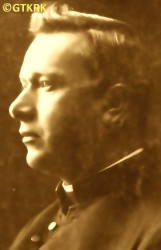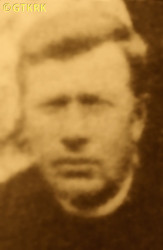Roman Catholic
St Sigismund parish
05-507 Słomczyn
85 Wiślana Str.
Konstancin deanery
Warsaw archdiocese, Poland
full list:
displayClick to display full list

searchClick to search full list by categories
wyświetlKliknij by wyświetlić pełną listę po polsku

szukajKliknij by przeszukać listę wg kategorii po polsku

Martyrology of the clergy — Poland
XX century (1914 – 1989)
personal data
surname
MICHASIONEK
forename(s)
Nicholas (pl. Mikołaj)
function
diocesan priest
creed
Latin (Roman Catholic) Church RCmore on
en.wikipedia.org
[access: 2014.09.21]
diocese / province
Mogilev archdiocesemore on
en.wikipedia.org
[access: 2013.06.23]
date and place
of death
1933

Veliky Ustyugtoday: Veliky Ustyug reg., Vologda oblast, Russia
more on
en.wikipedia.org
[access: 2022.07.16]
alt. dates and places
of death
08.05.1933
details of death
In 1923, after eviction from a house belonging to the church by the Russians, fearing impending arrest left out the parish house in Białystok village in Siberia and moved to Tomsk.
Yet on 03.04.1926 (or on 04.04.1927) arrested by Russians.
On 25.11.1927 — for „undermining the authority of the organs of the Soviet authorities in the representatives of the Catholic clergy abroad” and „attempted bribery”, because was to receive a thousand rubles from abroad in order to free another priest — sentenced by criminal Russian OGPU Council kangaroo court to 3 years of slave labour.
Sent to ITL SLON Solovetsky Islands concentration camp ITL SLON.
On 03.04.1931 (or 28.04.1930) released from camp but exiled for 3 years to Siberia and next to Veliky Ustyug (Vologda oblast in northern Russia), where perished in unknown circumstances (not later than 08.05.1933).
cause of death
extermination
perpetrators
Russians
sites and events
Forced exileClick to display the description, ITL SLONClick to display the description, GulagClick to display the description
date and place
of birth
20.07.1888

(f. Rēzekne county territory)today: Latvia
more on
en.wikipedia.org
[access: 2024.03.19]
alt. dates and places
of birth
Lisovskayatoday: Rēzekne mun., Latvia
presbyter (holy orders)
ordination
1911

positions held
1925 – 1926/7
curatus/rector/expositus — Malichevkaalso: Malichevskyi poselok
today: prob. non‐existent, Krivosheino reg., Tomsk oblast, Russia ⋄ St John the Baptist RC church ⋄ Tomsktoday: Tomsk city reg., Karelia rep., Russia
more on
en.wikipedia.org
[access: 2022.07.16], RC parish ⋄ Tomsktoday: Tomsk city reg., Karelia rep., Russia
more on
en.wikipedia.org
[access: 2022.07.16] RC deanery
1925 – 1926/7
parish priest — Novosibirsktoday: Novosibirsk oblast, Russia
more on
en.wikipedia.org
[access: 2021.12.18] ⋄ RC parish
1913 – 1923
curatus/rector/expositus — Belostokalso: Belostotskyi poselok
today: Krivosheino reg., Tomsk oblast, Russia
more on
en.wikipedia.org
[access: 2021.12.18] ⋄ St Anthony of Padua RC church ⋄ Tomsktoday: Tomsk city reg., Karelia rep., Russia
more on
en.wikipedia.org
[access: 2022.07.16], RC parish ⋄ Tomsktoday: Tomsk city reg., Karelia rep., Russia
more on
en.wikipedia.org
[access: 2022.07.16] RC deanery — minister of settlers in Siberia: the church in the village of Białystok served the villages of Białystok and Pydovka, inhabited by Polish settlers; also ministered St John the Baptist church in Malichevka, serving settlers from Latvia–Latgala, residing in the villages of Malichevka and Malinovka (also largely of Polish origin)
c. 1912
curatus/rector/expositus — Malichevkaalso: Malichevskyi poselok
today: prob. non‐existent, Krivosheino reg., Tomsk oblast, Russia ⋄ St John the Baptist RC church ⋄ Tomsktoday: Tomsk city reg., Karelia rep., Russia
more on
en.wikipedia.org
[access: 2022.07.16], RC parish ⋄ Tomsktoday: Tomsk city reg., Karelia rep., Russia
more on
en.wikipedia.org
[access: 2022.07.16] RC deanery — minister to the Polish settlers in Siberia
1911 – 1912
vicar — Tomsktoday: Tomsk city reg., Karelia rep., Russia
more on
en.wikipedia.org
[access: 2022.07.16] ⋄ Our Lady of the Rosary RC parish ⋄ Tomsktoday: Tomsk city reg., Karelia rep., Russia
more on
en.wikipedia.org
[access: 2022.07.16] RC deanery
till 1911
student — Sankt Petersburgtoday: Saint Petersburg city, Russia
more on
en.wikipedia.org
[access: 2020.07.31] ⋄ philosophy and theology, Metropolitan Theological Seminary
others related
in death
FILIPPClick to display biography Adolph, GRABOWSKIClick to display biography Francis
sites and events
descriptions
Forced exile: One of the standard Russian forms of repression. The prisoners were usually taken to a small village in the middle of nowhere — somewhere in Siberia, in far north or far east — dropped out of the train carriage or a cart, left out without means of subsistence or place to live. (more on: en.wikipedia.orgClick to attempt to display webpage
[access: 2014.12.20])
ITL SLON: Russian Rus. Исправи́тельно‐Трудово́й Ла́герь (Eng. Corrective Labor Camp) ITL Rus. Солове́цкий ла́герь осо́бого назначе́ния Ла́герь (Eng. Solovetsky Special Purpose Camp) SLON — concentration and slave forced labor camp (within what was to become Gulag complex) — headquartered in Solovetsky Islands in Arkhangelsk Oblast. Founded on 13.10.1923 in a famous Orthodox monastery. In the 1920s, one of the first and largest concentration camps in Russia. The place of slave labor of prisoners — at forest felling, sawmills, peat extraction, fishing, loading work on the Murmansk Railway Main Line, in road construction, production of food and consumer goods, at the beginning of the construction of the White Sea ‐ Baltic canal, etc. The concept of the later system of Russian Gulag concentration camps prob. had its origins in the Solovetsky Islands camp — from there the idea spread to the camps in the area covered by the construction of the White Sea ‐ Baltic canal, i.e. ITL BelBaltLag, and from there further, to the entire territory of the Russian state. From the network of camps on the Solovetsky Islands — also called the Solovetsky Islands archipelago — prob. also comes the concept of the „Gulag Archipelago” created by Alexander Solzhenitsyn. It is estimated that tens to hundreds of thousands of prisoners passed through the Solovetsky Islands concentration camps. At its peak, c. 72,000 prisoners were held there: e.g. 14,810 (12.1927); 12,909 (03.1928); 65,000 (1929); 53,123 (01.01.1930); 63,000 (01.06.1930); 71,800 (01.01.1931); 15,130 (1932); 19,287 (1933) — c. 43,000 of whom were murdered, including the years 1937‐1938 when c. 9,500 prisoners were transported from the camp and murdered in several places of mass executions, including Sandarmokh, Krasny Bor and Lodeynoye Polye. Among them were many Catholic and Orthodox priests. After the National Socialist Party came to power in Germany in 1933, a German delegation visited the ITL SLON camp, to „inspect” Russian solutions and adopt them later in German concentration camps. It operated until 04.12.1933, with a break from 16.11.1931 to 01.01.1932, when it was part of and later became a subcamp of the ITL BelBaltLag camp. It operated as such until 1939 (from 1936 as a prison). (more on: old.memo.ruClick to attempt to display webpage
[access: 2024.04.08])
Gulag: The acronym Gulag comes from the Rus. Главное управление исправительно‐трудовых лагерей и колоний (Eng. Main Board of Correctional Labor Camps). The network of Russian concentration camps for slave labor was formally established by the decision of the highest Russian authorities on 27.06.1929. Control was taken over by the OGPU, the predecessor of the genocidal NKVD (from 1934) and the MGB (from 1946). Individual gulags (camps) were often established in remote, sparsely populated areas, where industrial or transport facilities important for the Russian state were built. They were modeled on the first „great construction of communism”, the White Sea‐Baltic Canal (1931‐1932), and Naftali Frenkel, of Jewish origin, is considered the creator of the system of using forced slave labor within the Gulag. He went down in history as the author of the principle „We have to squeeze everything out of the prisoner in the first three months — then nothing is there for us”. He was to be the creator, according to Alexander Solzhenitsyn, of the so‐called „Boiler system”, i.e. the dependence of food rations on working out a certain percentage of the norm. The term ZEK — prisoner — i.e. Rus. заключенный‐каналоармец (Eng. canal soldier) — was coined in the ITL BelBaltLag managed by him, and was adopted to mean a prisoner in Russian slave labor camps. Up to 12 mln prisoners were held in Gulag camps at one time, i.e. c. 5% of Russia's population. In his book „The Gulag Archipelago”, Solzhenitsyn estimated that c. 60 mln people were killed in the Gulag until 1956. Formally dissolved on 20.01.1960. (more on: en.wikipedia.orgClick to attempt to display webpage
[access: 2024.04.08])
sources
personal:
biographies.library.nd.eduClick to attempt to display webpage
[access: 2014.12.20], catholic.ruClick to attempt to display webpage
[access: 2016.03.14], nkvd.tomsk.ruClick to attempt to display webpage
[access: 2019.05.30], www.gulagmuseum.orgClick to attempt to display webpage
[access: 2016.03.14], ru.openlist.wikiClick to attempt to display webpage
[access: 2019.05.30]
bibliographical:
„Fate of the Catholic clergy in USSR 1917‐1939. Martyrology”, Roman Dzwonkowski, SAC, ed. Science Society KUL, 2003, Lublin
original images:
nkvd.tomsk.ruClick to attempt to display webpage
[access: 2019.05.30], www.russiacristiana.orgClick to attempt to display webpage
[access: 2014.12.20], ipn.gov.plClick to attempt to display webpage
[access: 2019.02.02]
LETTER to CUSTODIAN/ADMINISTRATOR
If you have an Email client on your communicator/computer — such as Mozilla Thunderbird, Windows Mail or Microsoft Outlook, described at WikipediaPatrz:
en.wikipedia.org, among others — try the link below, please:
LETTER to CUSTODIAN/ADMINISTRATORClick and try to call your own Email client
If however you do not run such a client or the above link is not active please send an email to the Custodian/Administrator using your account — in your customary email/correspondence engine — at the following address:

giving the following as the subject:
MARTYROLOGY: MICHASIONEK Nicholas
To return to the biography press below:
 Click to return to biography
Click to return to biography










